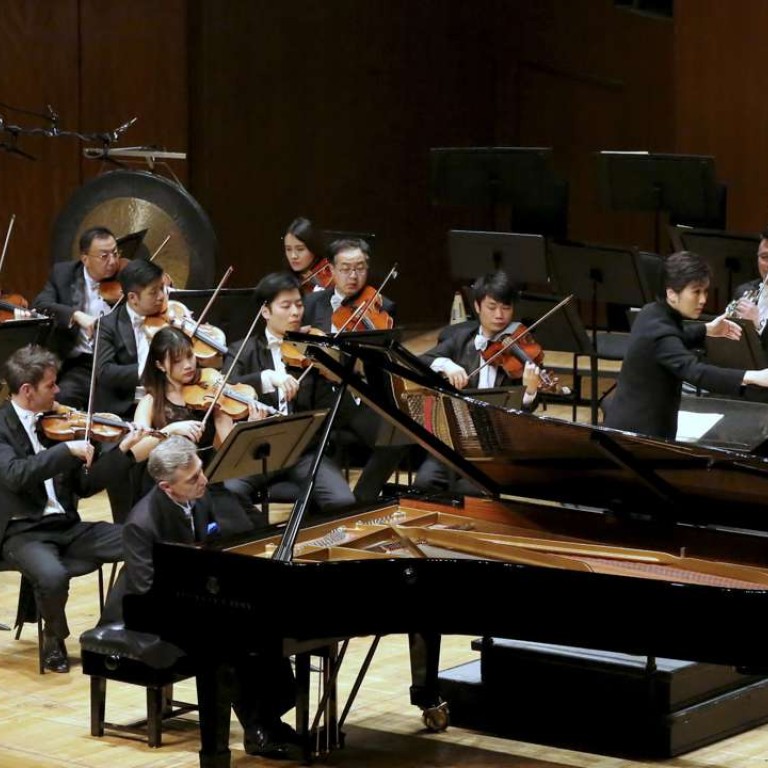
Review: Michel Dalberto and Hong Kong Sinfonietta - power and panache
French pianist tackled contrasting works by Mozart and Richard Strauss with grace and steely brilliance, concertmaster shone conducting Haydn and orchestra hit a high standard throughout
This Le French May programme was one of the most successful Hong Kong Sinfonietta concerts in recent memory, with elegant Haydn, sparkling Mozart and powerful Richard Strauss.
Having a player from within an ensemble lead music from the pre-Romantic era is becoming more common, and concertmaster James Cuddeford led from his seat the orchestra’s performance of Haydn’s Symphony No 6 in D, Le Matin (“Morning”). He deserves a big bravo.
With only slight nods and upward bow gestures for guidance, the players sounded as disciplined and united as a string quartet. The tempos were right and the strings and winds were balanced. Varied textures animated the poetry of the music, such as the gentle dawn played by veiled strings and bright birdsong from the solo flute. Beginnings and endings were precise and crisp.
The ringing chord at the end of the first movement showed just how in tune and on time the players were. Haydn included some showy solos in this piece and they were expertly played by flute, oboe and cello. Cuddeford himself played his solos with radiant sound.
Mozart’s Piano Concerto No 14 in E flat was written for his gifted student, pianist Barbara Ployer. French pianist Michel Dalberto made sense of the quirky first movement, with a firm, crisp touch that carried easily over the orchestra.
The opening theme changes key and stops and starts in a stuttering way, but Dalberto kept the line going through Mozart’s darting changes of direction. In the slow movement, the music began to bloom as the piano had a richer, fuller texture, and Dalberto played the decorative notes with a graceful flourish.
The final movement started with Baroque-style counterpoint, another exercise for a talented pupil. The piano entered with a quicker layer, and the bright momentum continued over the bouncy texture, interspersed with opera-like tunes. The orchestra and soloist dexterously bantered phrases back and forth, and there was a surprise coda in 6/8 jig time, ending the piece with a kick.

In contrast to Haydn, the music of Richard Strauss is unthinkable without a conductor hard at work keeping everything together.
His Burleske in D Minor for Piano and Orchestra is a romantic extravaganza. It requires steely brilliance from the pianist and Dalberto had plenty of power for the non-stop octaves, tremolos, runs and crossed hands.
Launched with the theme played on four timpani, the orchestra was more than just background and they melded well with the soloist. The most memorable moments were the gorgeous waltzes topped with piano filigree.
Strauss’s Death and Transfiguration is a mature piece (although written when he was only 25) and depicts an artist who strives to achieve the “ideal” and succeeds only after death.
Strauss could make an orchestra paint any picture, no matter how far-fetched. The hesitant breaths of a dying man, played with soft strings, were made vivid. Harps and oboe wove into his dreams. Contrabassoons and cellos depicted anger and fear. A gong was the instant of death.
For transfiguration the music rose little by little over a drone, like a bubble in water.
Despite a few minor quibbles, such as harsh low woodwinds, a few awkward cut-offs and oddly loud harps, the orchestra hit a high standard here, with beautiful balance, intonation and pacing.
Conductor Yip Wing-sie has gift for long arcs and heroic arrival points with nothing held back. She kept the cresting waves of sound rolling on, reaching the saturation point of brass, strings, woodwinds and percussion. The preposterous idea of an artist achieving perfection after death seemed plausible with these ravishing sounds filling the air.
Hong Kong Sinfonietta, Michel Dalberto Plays Mozart and Richard Strauss. City Hall Concert Hall. Reviewed: May 7
